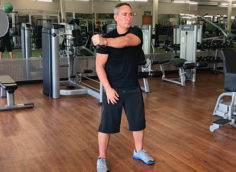Mechanical drop sets allow you to continue a set when you've reached fatigue. Typically, this is done by adjusting the position of an exercise as you go from a harder to easier variation.
Think reverse dumbbell curl, then regular curl, then hammer curl. Drop sets like this increase time under tension, which helps build muscles and muscular endurance.
Doing dumbbell or kettlebell exercises in an alternating fashion can be another way to employ mechanical drop sets. With alternating reps, you can have your non-working arm do isometric holds in either the contracted or stretched position.
As fatigue builds up, simply switch to a variation where the pause is less challenging. And since this will challenge you with submaximal weights, it can be a joint-friendly method while still creating substantial muscular stress.
Three Types of Reps
Your set will consist of three types of reps:
- Switching arms at the top. For a dumbbell bench press, one arm would be fully extended while the other presses. Then the other arm holds at the top while the formerly extended arm lowers down and comes back up.
- Switching at the bottom. One arm would be bent at the bottom of the movement while the other arm pushes up, then they switch.
- Working both arms at the same time. Both arms go through the range of motion.
But they don't have to be in this order. You want to do the hardest hold first. The order you do them in will depend on the exercise.
When doing a dumbbell curl for example, switching arms at the top contracted position will be more challenging as you maintain tension. Therefore, you'd hold it there first. Alternating in the bottom will be easiest as the free arm gets extra rest when it's straight.
Here's a closer look at how to do this with a variety of exercises:
Alternating Dumbbell Bench Press
Do reps switching at the bottom first with the dumbbells close to your pecs. Maintain tension in this bottom position and avoid laxity in the isometric arm.
When fatigued, switch to pressing with both arms, then finish with reps switching at the top.
Alternating Dumbbell Curl
Do reps switching at the top of the curl. Progress to curling with both arms at the same time, then finish with alternate curls switching at the bottom. A little body English is okay here.
Alternating Dumbbell Shoulder Press
These are a little different since both arms in flexion overhead can be a challenge on core stability and thoracic extension. I also prefer the half-kneeling position for this reason since it'll minimize compensation through the lumbar spine.
Start pressing both weights at the same time. Move to alternate reps switching at the top. Finish with alternating at the bottom by your shoulders.
If mobility is an issue, do these while seated on a high incline bench. For shoulder health, use more of a neutral grip.
Alternating Dumbbell Row
You can do these chest-supported on an incline bench or standing. Switch arms at the top. Really focus on driving the elbows back and squeezing the lats and upper back. Then move to a two-arm row. Finish the set by alternating at the bottom.
Lying Dumbbell Triceps Extension
Do all reps with the weights in line with your forehead or higher. This will maintain tension on the triceps.
Start by alternating at the top. Move to bilateral or rolling dumbbell extensions. Finish by alternating at the bottom. Accentuate the stretch on the triceps by keeping the elbows held high with your hands close to the shoulder.
Lateral Raise
Raise one dumbbell to shoulder height and hold it. Bring the other arm up and form a T. Bring the first arm back down to the thighs. Alternate reps in this fashion. Then move to traditional lateral raises and finish the set by switching at the bottom.
Tips
- Don't go to complete failure until the last phase of the set. Always keep a rep or two in the tank before doing the subsequent drop set.
- For compound lifts like presses and rows, a good rule of thumb is to start with a weight you could do roughly 5-10 times with a rep in reserve. If you're unable get a few reps with each drop set, you started too heavy.
- For accessory moves like lateral raises and triceps extensions, begin with a higher rep range of around 6-10 with a rep in reserve.
- Use this on the last set of an exercise OR you can do this across all sets. Expect to decrease your weight with each successive set.
- Use the method for no more than two exercises in a session.
- Be creative. See where else you can apply this concept with your own exercise choices.
Benefits of Isometrics
Static training can be mentally tough when the seconds start to add up. With this alternating method, you accumulate considerable time doing static holds in various positions without really thinking about it. According to Supertraining, fluctuating rep tempo during a set could be a way to avoid stagnation for a seasoned lifter.
Since the location of the pause changes as fatigue builds, this happens naturally during the set. Pauses also engrain solid lifting technique since cheating is minimized. Lastly, isometric holds strengthen tendons and joint capsules in addition to the recruited muscles.
This simple technique doesn't require much resistance, but it's not easy. Add it to your training toolbox.
Source
- Verkoshansky, Y., & Siff, M. (2009). Supertraining: expanded version (6th ed.) Rome: Ultimate Athlete Concepts.





